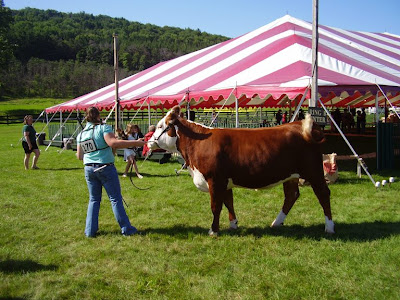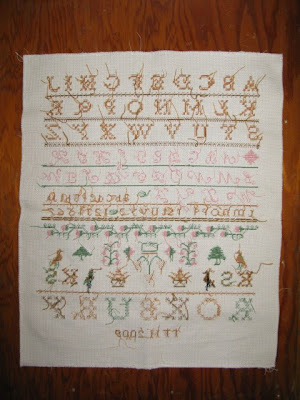By: Erin Crissman, Curator
Across the street at
Fenimore Art Museum, is a great exhibition of
Walker Evans' photography from the 1930s.
Walker Evans: Carbon and Silver shows how much additional detail can be shown in these iconic American photographs by re-printing them with today's digital technology. I
realised when I was looking at the work during the exhibition's opening a few week's ago that I wasn't looking at the photographs, but concentrating on what was in them. When I look at art, I think about how it documents everyday life from its time period. For The Farmers Museum's historic village buildings, I often look at paintings, drawings and lithographs from the 1840s for clues about how to place
furniture, what window treatments to use and what wallpaper should be on the walls. So, at the Walker Evans exhibition, I was looking at how Evans' photographs documented how his subjects lived in the 1930s. Here are a few examples:
These two photographs show the same home's kitchen. The first one is taken from the outside, and the second one from the inside of the house. How can I tell? The same chair is in both photographs, though it is clear that the family either had more than one, or that Evans rearranged the kitchen for his photograph. Also, on the wall in the second photograph is the dasher and lid for a butter churn. In the top photograph, the churn is sitting on the cabinet's enamel counter. I wonder if this family had a cow?
This family's home is incredibly clean. The towel and bowl serve as a washstand to wash hands as they're entering the house. All of the surfaces are look clean and shiny and they have a broom, albeit well-worn, in the corner. Only the kerosene lamp's chimney needs cleaning.
Many of the tenant farmer families Evans photographed in the 1930s were living in much the same way that some families lived in the 1840s. They had no electricity or indoor plumbing and were still churning their own butter. Although I look at these photographs today and see hardship, I also see that this family was making the best out of what they had and taking excellent care of their few possessions.
Top: Farmer's Kitchen, Hale County, Alabama 1936
Bottom: Kitchen Corner, Tenant Farmhouse, Hale County, Alabama 1936
 If you visit the More House this year, you may come across a volunteer sewing together the pieces of a bandbox. The bandbox volunteer group, spearheaded by lead volunteer Martha Duke, is an enthusiastic new group at the museum. They have learned the techniques and history of bandbox-making, which they demonstrate in the sitting room of the More House.
If you visit the More House this year, you may come across a volunteer sewing together the pieces of a bandbox. The bandbox volunteer group, spearheaded by lead volunteer Martha Duke, is an enthusiastic new group at the museum. They have learned the techniques and history of bandbox-making, which they demonstrate in the sitting room of the More House.
 I love this new group! Not only does it add to the activity in the More House, but I’m learning new things every week about bandboxes and how they’re made. It’s also fun to see even more colorful wallpaper than already covers the walls in the house (more on the More House wallpaper in a future post).
Bandboxes originally were made in England and served to store men’s detachable neck bands (collars). By the nineteenth century, Americans had adapted bandboxes to store a wide variety of hats, accessories, and other trinkets; women also used them as luggage while traveling.
If you are interested in volunteering on this project, please contact our Volunteer Administrator at volunteers@nysha.org. The bandboxes are also available for sale at Todd’s General Store.
Photos: Martha Duke sews together a bandbox lid in the More House sitting room, with several finished boxes in the background.
I love this new group! Not only does it add to the activity in the More House, but I’m learning new things every week about bandboxes and how they’re made. It’s also fun to see even more colorful wallpaper than already covers the walls in the house (more on the More House wallpaper in a future post).
Bandboxes originally were made in England and served to store men’s detachable neck bands (collars). By the nineteenth century, Americans had adapted bandboxes to store a wide variety of hats, accessories, and other trinkets; women also used them as luggage while traveling.
If you are interested in volunteering on this project, please contact our Volunteer Administrator at volunteers@nysha.org. The bandboxes are also available for sale at Todd’s General Store.
Photos: Martha Duke sews together a bandbox lid in the More House sitting room, with several finished boxes in the background.



 I've spent a lot of my life
I've spent a lot of my life 
 3) In the early fall, and sometimes on these rainy summer days, historic fireplaces are glowing with a toasty-warm fire.
3) In the early fall, and sometimes on these rainy summer days, historic fireplaces are glowing with a toasty-warm fire.  4) Although technically outside, the buildings are very close together, so if you're willing to run between the raindrops you won't even get wet! Stay and play games in the country fair tent for as long as you like.
4) Although technically outside, the buildings are very close together, so if you're willing to run between the raindrops you won't even get wet! Stay and play games in the country fair tent for as long as you like. Remember to wear rain boots and bring an umbrella and an extra jacket. I've acquired cute pink rain boots, and more recenty, some rainy-day shoes. If you have a family with small children, bring some extra clothes and hot chocolate for the ride home in case they're a little damp and chilly. Rainy days were, and still are, some of my favorite days at work. Hope you'll venture out to a living history museum on a rainy day, too!
Remember to wear rain boots and bring an umbrella and an extra jacket. I've acquired cute pink rain boots, and more recenty, some rainy-day shoes. If you have a family with small children, bring some extra clothes and hot chocolate for the ride home in case they're a little damp and chilly. Rainy days were, and still are, some of my favorite days at work. Hope you'll venture out to a living history museum on a rainy day, too! 


 It’s been a great two days of livestock showing. Congratulations to all our exhibitors!
It’s been a great two days of livestock showing. Congratulations to all our exhibitors!










 As I’ve stitched in the More House, many visitors have asked what will happen to this sampler. It will stay in the More House for visitors to see. In the entire scope of the project, though, I still have far to go. My next step will be to go back to the original sampler to check against my first try, note my mistakes, and fix anything major on this sampler. Then I will start matching thread colors and material so I can start on an even bigger task: reproducing, as much as possible, the original sampler on linen cloth (without the benefits of the grid-like aida cloth). But after this one, I’m feeling much more ready for the challenge!
As I’ve stitched in the More House, many visitors have asked what will happen to this sampler. It will stay in the More House for visitors to see. In the entire scope of the project, though, I still have far to go. My next step will be to go back to the original sampler to check against my first try, note my mistakes, and fix anything major on this sampler. Then I will start matching thread colors and material so I can start on an even bigger task: reproducing, as much as possible, the original sampler on linen cloth (without the benefits of the grid-like aida cloth). But after this one, I’m feeling much more ready for the challenge! 